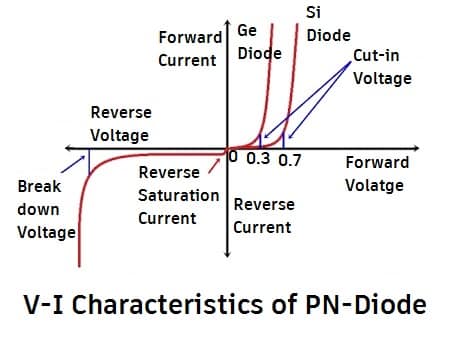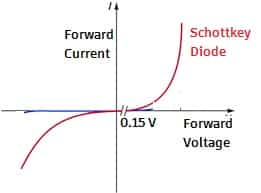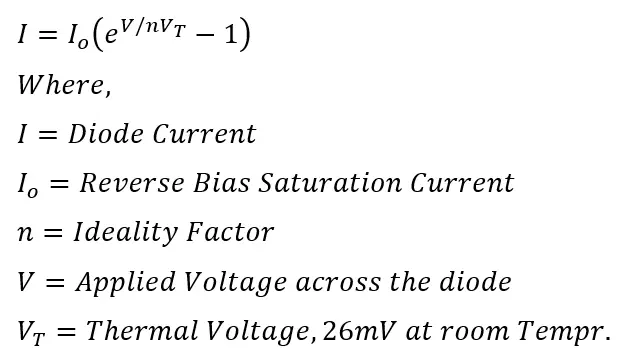In this post, we will discuss the concept of cut-in voltage of the P-N junction diode.
What is the Cut in Voltage of the P-N Junction Diode?
The forward voltage at which the diode starts conducting is called the cut-in voltage of the diode. At cut-in voltage, the diode conducts heavily. There is no linear relationship between voltage and current. In short, the diode exhibits non-linear characteristics.
Cut-in Voltage of Silicon and Germanium Diode
The cut-in voltage of various didoes is different. The silicon & germanium diode have cut-in voltage 0.7 volts & 0.3 volts respectively. The graph below shows the cut in voltage for germanium and silicon.

| Diode | Cut in Voltage( V) |
| Germanium | 0.3 V |
| Silicon Diode | 0.7 V |
Cut-in Voltage of Schottky Diode
The Schottky diode has a cut-in voltage of 0.15 V. The diode does not allow the current through it if the voltage is less than the specified cut-in voltage of the diode.

Cut-in Voltage of Zener Diode
The cut-in voltage of a Zener diode is similar to that of a regular P-N junction diode when it operates in the forward bias condition. In this mode, the Zener diode behaves like a normal diode with a cut-in voltage of:
- Silicon Zener Diode: ~0.7V
- Germanium Zener Diode: ~0.3V
The Zener diode does not have a traditional cut-in voltage in reverse bias. Instead, it has a Zener breakdown voltage (Vz), the voltage at which it starts conducting in reverse to regulate voltage.
Thus, the concept of cut-in voltage applies to Zener diodes only in forward bias, while in reverse bias, the Zener breakdown voltage is the key parameter.
Cut-in Voltage of Light Emitting Diode(LED)
The cut-in voltage of a Light Emitting Diode (LED) is the minimum voltage required for it to start conducting and emitting light. It varies based on the semiconductor material and the wavelength (color) of light emitted.
Typical Cut-in Voltage for Different LED Colors
| LED Color | Material Used | Approx. Cut-in Voltage (V) |
| Infrared (IR) | GaAs (Gallium Arsenide) | 1.2V – 1.6V |
| Red | GaAsP (Gallium Arsenide Phosphide) | 1.6V – 2.0V |
| Orange | GaAsP / GaP (Gallium Phosphide) | 2.0V – 2.2V |
| Yellow | GaAsP / GaP | 2.0V – 2.4V |
| Green | GaP / GaN (Gallium Nitride) | 2.2V – 3.5V |
| Blue | GaN / SiC (Silicon Carbide) | 2.5V – 3.7V |
| White | GaN with phosphor coating | 3.0V – 3.7V |
| UV (Ultraviolet) | GaN / AlGaN | 3.1V – 4.5V |
Cut-in Voltage Formula
The cut-in voltage of a diode is determined using the diode equation.

Why is Cut-in Voltage Important?
The most common function of the diode is to conduct in the forward direction and to remain cut-off during the reverse direction. Thus, the diode conducts only in the forward bias condition and blocks the current in the reverse bias condition. We can say the diode acts as a check valve.
The cut-in voltage of a diode is important because it determines the minimum voltage required for the diode to conduct significant current in the forward-biased condition.
What is the cut-off Voltage of the Battery?
In batteries, the cut-off voltage is the specified lower-limit voltage at which battery discharge needs to stop. The battery is out of charge when the battery voltage is equal to its cut-off voltage. The cut-off voltage is usually chosen so that the maximum useful capacity of the battery is achieved.
This is all about the concept of cut in voltage.
Read Next: